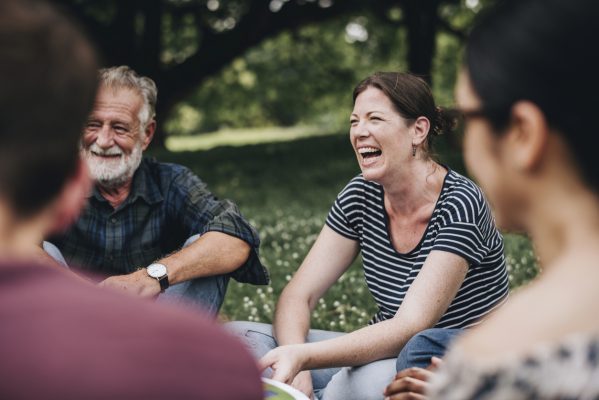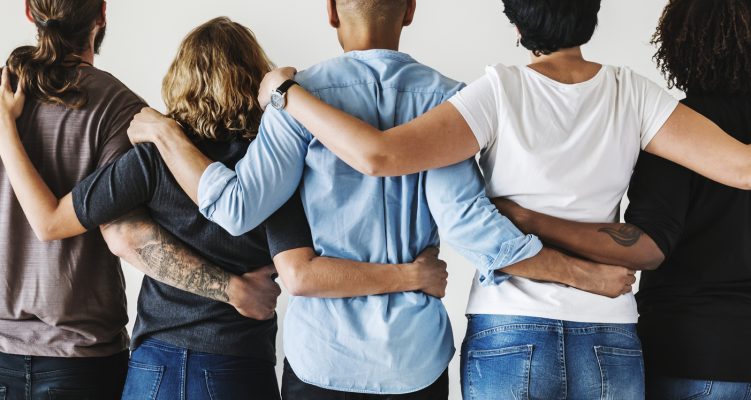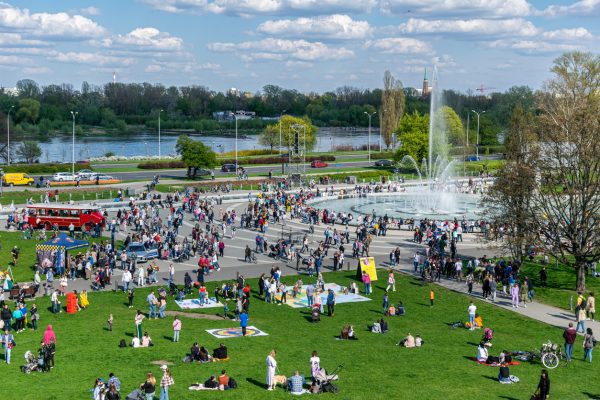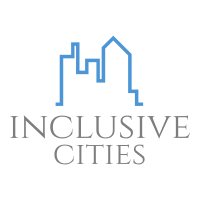Chapter 2: Get to know your neighbors: defining the target groups
The importance of understanding your community
Many project managers and NGO activists start their activities with researching and understanding their target audience, understood as people to whom your action is addressed and who will directly benefit from it. This is a great starting point, as it helps you understand the main challenges your community is facing and the needs your future beneficiaries would like to have fulfilled. In result, you can design your projects activities accordingly, so that they are rooted in the context and strongly linked to realities the people you work with are facing.
This sounds like a very reasonable approach that should help you build more successful, impactful, and sustainable projects. There are, however, several questions you need to ask yourself in order to do it in the best, most effective way possible.
What is a community?
Community need assessment is a widely spread concept and many people use it when designing a project, but it is important to really understand the concept of community first. So how could the community be defined?
A basic, intuitive definition would be that community is simply a group of people who live in a geographical proximity, for example residents of a specific village, neighborhood, or city. Alternatively, community can be seen as a group of people who have something in common and/or share a common purpose. However, defining community in such a broad way does not really give much insight as it does not really touch the essence of what a community really is.
The word community itself comes from Greek – it can be loosely translated as “fellowship”, or a group of people who come together to support each other and to fulfill each other’s’ needs. This underlines very important aspects of community – interdependence, connections, and a sense of unity.
When it comes to more scientific definitions, we would like to propose two:
A human system of more than two people in which the members interact personally over time, in which behavior and activity are guided by collectively – evolved norms or collective decisions, and from which members may freely secede
The key element of this definition is the realization that communities are ruled by norms that were developed over time. Without understanding these norms, it is really challenging to design and implement a successful project that would be enthusiastically embraced by the public.
Another definition states that clusters of individual lives make-up communities, societies, and cultures. To understand some of the complexities, complications, and confusions within the life of just one member of a community is to gain insights into the collective.
What we would like to underline in this definition is that sometimes when doing research, there is a risk of focusing on community as a group, but it is important to remember that the group actually consists of individuals.
When it comes to creating inclusive, open urban spaces, we of course have to set up some geographical limitations or borders while researching our community. This could be a neighborhood, a district, or a whole city, depending on the problem we would like to research and the project we would like to implement. Once deciding on the geographical sphere of the actions, the key is to really understand the realities of this particular area.
The role of community
Before you conduct the need assessment or plan any project, it is important not only to understand what a community is, but also to explore what are its functions and roles in people’s lives. This is crucial since everything you do as an NGO worker interested in building more inclusive cities, should be always rooted in the context of community, as desirably your actions should not be limited to a specific group, but rather should have a positive, sustainable impact of communities as a whole.
So what are the roles and functions of a community? Why do people actually need them? There are several benefits of communities we suggest you take into consideration:

They provide support. Being a part of a well-functioning, close knitted community, gives people a sense of belonging. They generally feel less alone, which is important especially when it comes to facing different problems and challenges. The support is manifested in different levels, including financial, emotional, or related to sharing resources and ideas.

They empower. When being part of a community, people feel more inclined to take action, raise their voice, stand up for themselves, and advocate for the issues that are important to them not only as individuals, but also for others who belong in the same community. When surrounded by people who share similar values and/or interest, people are more likely to become changemakers and start a grass root movement.

They enhance creativity. Communities are a lot about sharing – there is, on many levels, a constant exchange of ideas and thoughts that inspire people to not only discuss problems and challenges, but also to find solutions that are innovative and creative.

They are a learning space. Communities, even small ones, always consist of members who have different backgrounds and life experiences. Thanks to this, people are exposed to new knowledge and also have access to new resources that are otherwise inaccessible for them as individuals.

They help building connections. Being part of a community make people feel closer to each other, which in turns brings them not only a sense of belonging, but also a sense of security, especially on an emotional level.
Knowing what the benefits and positive sides of communities are, helps you, as a project organizer and activist, to plan your activities better. While organizing any actions or planning a new urban project, it is important to always plan how to strengthen the community you work in, bring people closer together, and underline a positive sides of actually belonging to a community, so that people you work with are more eager to get involved.
What are the characteristics of the community – defining factors
Below are some crucial aspects that need to be taken into consideration when you want to really understand your community. You should investigate those even before you attempt to have a more in-depth community need assessment.
Infrastructure: What are the elements of the geographical area without the inhabitants cannot function? Think of really necessities, such as transportation, roads, access to internet, electricity etc.
Settlement and living patterns: Where and how do people live? How is the space divided when it comes to income level? Where are the poorer and more affluent neighborhoods located? Is safety/crime level different in different areas?
Demographics: Who are the residents? Think of basic statistical information, such as age, gender, education and income levels etc. Research information and key facts about people with migration/refugee background too.
Historical background: What is the past of your community? What are the long-term traditions? What are the local elements that people feel connected to or proud of? What are the dark moments of history that the community is not willing to explore?
Leaders: Who are the people who have influence in the community? Identify both formal leaders (such as politicians, representatives of institutions, public figures) as well as informal leaders (such as activists, neighborhood leaders etc)
Groups and institutions: What are the entities (formal and informal) people belong to or identify with? Think of religious groups, culture clubs, senior associations, sports clubs etc.
Once you have all those factors identified, it will help you to understand the context of your city/neighborhood better. Without understanding what you are dealing with, it is very difficult to plan a project that will be successful, meaning that it will be well received by a public, but also that it will have a positive, visible, and lasting impact on the community you are working in.
Community building and working with people at risk of exclusion
If building a more inclusive, open city or neighborhood is your goal, then it is of crucial importance to acknowledge that it is not possible to obtain it without actively trying to reach out marginalized groups, minorities, and other people who for some reason are vulnerable and in result are not fully included in the community.
In order to be able to include different marginalized groups into your inclusive urban projects, you need to first know who they are, why they are not fully included in the community, and what are their needs, and what challenges they are facing.
Especially the answer to the questions of needs and challenges really depends on the particular group – people face different obstacles depending on their background, and therefore need solutions that are adjusted to their specific needs. That is why it is important to have a very good overview of those groups and their characteristics before you start doing any projects.
Here are some examples of vulnerable groups of adults that are especially at risk of being marginalized:
How it works
The list of people and groups at risk of exclusion is open – in your community there might be other groups that are marginalized, that is why it is important to conduct research that will show you specific groups and specific problems and challenges that are relevant to the context you operate in.
People with migration/refugee background. Migrants, especially those newly arrived, struggle to feel fully included in the community as they encounter many barriers, such as lack of knowledge of the language of the country, lack of understanding towards social and cultural norms, inability to pursue a career even though having a profession and other. Many of them, especially those who were forced to immigrate, suffer from psychological and/or physical traumas that prevent them from building a life in their new community.
This group is the most relevant to analyze in the context of this guidebook and the topic of our project, but when attempting to build a more inclusive community, we suggest you also investigate other groups at risk of exclusion present in the are you are operating. These groups might include:
People with low socioeconomic status. Lack of adequate, regular income is strongly linked with lower level of education and lack of competences that could help build a better career. In result, people with low socioeconomic status are more likely to become homeless, get addicted, or commit a crime. Since people who struggle with finances are mostly preoccupied with making ends meet, they are less likely to get involved in community life, they also have limited access to cultural offer or opportunities to spend leisure time in a more creative way.
People with migration/refugee background. Migrants, especially those newly arrived, struggle to feel fully included in the community as they encounter many barriers, such as lack of knowledge of the language of the country, lack of understanding towards social and cultural norms, inability to pursue a career even though having a profession and other. Many of them, especially those who were forced to immigrate, suffer from psychological and/or physical traumas that prevent them from building a life in their new community.
This group is the most relevant to analyze in the context of this guidebook and the topic of our project, but when attempting to build a more inclusive community, we suggest you also investigate other groups at risk of exclusion present in the are you are operating. These groups might include:
People with low socioeconomic status. Lack of adequate, regular income is strongly linked with lower level of education and lack of competences that could help build a better career. In result, people with low socioeconomic status are more likely to become homeless, get addicted, or commit a crime. Since people who struggle with finances are mostly preoccupied with making ends meet, they are less likely to get involved in community life, they also have limited access to cultural offer or opportunities to spend leisure time in a more creative way.
The elderly. People who retired often feel excluded – since they do not have a job, they lack routine and find it challenging to get involved, especially if they were professionally active for many years. In many cases they do not feel needed anymore and this feeling can result in isolation and loneliness. Studies show that elderly people would like to stay socially active, but they do not know how to start, as many of them seem to believe that most cultural, social, or educational offer is only directed to younger generation.
People with disabilities. People with both mental and physical disabilities often face structural barriers that prevent them from staying actively involved in the community. For people with physical disabilities these barriers are mostly present when it comes to physical space (buildings, public transportation) not being accessible and adjusted to their needs. People with mental disabilities often face stigma and lack of understanding towards their special needs from the rest of the community, which also prevents them from being involved.
CONCLUSION
The list of people and groups at risk of exclusion is open – in your community there might be other groups that are marginalized, that is why it is important to conduct research that will show you specific groups and specific problems and challenges that are relevant to the context you operate in.
Whatever the group at risk is, it is crucial to take into account that there are also outside factors that prevent them from being included and involved in the community. In this sense, not everything is depended on the people themselves, there are also structural and social barriers that need to be taken into consideration. These can be physical barriers like those already mentioned in this chapter (architecture, city planning, lack of policies), but also less tangible, social barriers, that are mostly attitudes of the other members of community who often fear the unknown and based their actions on prejudices. The conclusion here is that when you attempt to dismantle these barriers, you should work closely with multiple actors and stakeholder – people at risk of exclusion themselves, general population of the community, and the officials. Especially when it comes to prejudices and attitudes that are stemming from fear, it is important to bring different people together and provide them with a safe space to engage in a dialogue that does not negate differences, but rather encourages people to focus on the similarities between them, so that they can coexist in the same communities.
Why some people remain outside of the communities
As mentioned, there are many reasons why people are excluded and not part of the community. There are different, internal, and external factors that cause that. In this section, we would like to focus more on factors and barriers existing inside of the community, that may prevent people who are not traditionally part of it to feel more included.

Communities change
Communities, like all the other social structures, are subject to changes. They grow and evolve constantly and whereas some norms remain intact for many generations, others are changing or are being rejected all together. These changes do not happen in a vacuum – they are very often shaped by external factors, such as political forces or profound social/cultural/historical events. These changes sometimes influence the ways in which communities see their own members. For example, after 9/11 attack on the World Trade Center, community attitudes towards people with different cultural or religious background were changed to more hostile and based on fear.

Communities are built around similarities
Communities take time to be built, and when they are well established, they are typically based on similarities, common values, norms, and patterns of behavior. That is why, when society as a whole changes and there is influx of people who do not share those similarities (most notably migrants/refugees), members of the community tend to (at least initially) react with fear. In some cases, this fear prevails and leads the community to remain close, as it is easier to isolate than to deal with unknown.

Solutions and ideas within the community are designed for groups, not for individuals.
The bigger the community (both in terms of population and the geographic area), the more difficult is to implement initiatives and solutions that cater for the needs of individuals. It is more practical that introduce improvements that are good for an average member of the community, as taking into account the needs of all the individuals it is not only time, resources, and energy consuming, it also seems like an impossible task, hence the needs of some people are never taken into consideration.

Communities have limited resources.
As communities in many cases are not structured (at least formally or institutionally), many initiatives are spontaneous and/or grassroots. Sometimes the members would like their community to be more open, or to cater more for special needs of different people, but they do not feel they have capacities or resources to introduce change.
Knowing the reasons of exclusion and the limits of the community you work in, is useful as it helps you to plan your activities better and implement projects that answer to the main needs and address the most pressing challenges that are faced by both people who are already well included in the community and those who remain outside.
Community need assessment
Community need assessment is a study of the local community to learn about its needs and expectations. The purpose of your diagnosis is to learn about the needs, expectations, and problems of the community in relation to the issue you are addressing. When conducting an assessment, you tap into the knowledge and experience of the people who make up your community, experts, as well as organizations and institutions associated with the community. Remember to reach out to important but often excluded groups of residents – those whose voice is often not taken into account, such as the elderly, people with disabilities, people with low socioeconomic status and most importantly people with diverse cultural background, such as refugees, migrants, and members of minority groups.
Conducting the need assessment will enable you to gain reliable knowledge that will give you a good understanding of your environment and the context. It will provide arguments in discussions with representatives of the municipal authorities and other stakeholders, with whom you should cooperate in order to create projects that are more impactful and more sustainable. The knowledge gained as a result of the need assessment is the basis for good planning of activities, it also creates space for residents to express their own needs and opinions on a particular issue.
Need assessment that is carried out by the members of a community themselves, is the so-called participatory need assessment. Your advantage is that you know the local contexts, so you can reach out to particular groups of residents even those who are often left out of conversations about issues important to the community, or do not usually get involved themselves.
ToolKit
You can get to know specific tools for participatory, creative need assessment in our ToolKit.
How to conduct a need assessment without discouraging your public
Need assessment is necessary for before every project, but it has to be done in a way that not only brings good results but also is engaging to the members of community you investigate. The more engaging and properly conducted the need assessment is, the more likely you are to reach out to beneficiaries that are normally not involved in the community life.
Here are some important things to consider:
- The need assessment must be visible in the community. This means that you let residents know who is conducting the assessment and for what purpose. This will ensure that residents are aware of who you are and why you are working on the specific topic you have chosen.
- You should make an effort to reach out to many different groups and stakeholders, especially those who are normally marginalized and do not have a lot of possibilities to raise their voice on the important community issues.
- Present the collected results to the community and residents participating in your survey. You should also remember to give residents a chance to give you feedback on the results themselves and on how the survey was conducted.
- The results of your need assessment should be widely available and understood by residents. In this way you will be able to count on greater understanding and support for actions based on the results of the diagnosis carried out.
- Remember to let the residents know about the planned activities and opportunities to get involved in the next steps of your research or the activities that result from the community need assessment.

Before you start talking to the members of your community, you should be well informed about the topic you are dealing with, recognize the problem you have decided to investigate. It is advisable to familiarize yourself with official documents and data, the budget of the municipality if you are planning to apply for funding for your future ideas. You should also gather and analyze information published on the Internet and in the local press on the topic you are interested in. Comprehensive information gathering will allow you to determine exactly what you want to investigate (what the problem is) and why (what the goal is), and who to talk to in order to get the information you are interested in. This is necessary in order to design the need assessment in a way that will help you gather all the information you need.

It’s not only about needs – conducting a resource assessment
Need assessment is important, as in answers to several, crucial questions, such as:
- what is lacking in the community?
- what should be improved?
- what are the main problems and challenges to be tackled?
- what are the areas of live in the community that need to be improved?
These are of course really essential points to consider while planning any community action and having the residents answering those questions can give you a really good starting point. Once you know what they want and need, you can start designing a project that aims at bringing positive changes in the community. If you link your ideas to the identified needs, your project is more likely to have results that are impactful and sustainable in a mid- and long-term perspective.
However, the challenge or disadvantage of need assessment as a basis of your future projects is that it is incomplete, in a sense that it is mostly focused on identifying what is lacking. That is why we recommend you to not only focus on what is lacking, but also to implement activities aiming at identifying what the community already has.
To do that, it is recommended to conduct a community resource (or assets) assessment.
Assets, or resources, are generally the things that exist in the community that can be used as an advantage when it comes to improving the life of the residents and building more resilient, inclusive cities. These assets can be both material – for example the existing infrastructure, cultural/educational/career opportunities, that are already in place – and non-material, such as people, relationships between them, values, and practices that are already being successfully implemented.
So how do you conduct a community resource assessment? First step is to conduct a desk research, to identify the areas that you can build upon while designing your future projects. Here are some areas you can take into consideration:
Leadership. Are there any community leaders that are well respected and could be involved in your project in order to make your activities better known and accepted? Once you have the support of the leaders it is easier to convince the general population of residents to be on board with your ideas.

Human resources. Do you, as an organization or a public institution have enough of staff to implement the project you have in mind? What skills and competences people in the community already have? How could you use those skills during your project?

Partnership and collaboration. Identify the organizations, institutions, formal and informal group of interests with whom you could collaborate during your project. What could they bring to make your project more successful? Try to focus on avoiding competition and see other organizations working in the same sphere as possible partners, as in the end you all share a common goal, which is to make the urban community you operate in a more inclusive, open place.

Apart from the classical research, you can also use more creative, participatory methods that allow you to work directly with your target groups. It is important to involve adults at risk in any kind of pre-project activities during which you investigate the needs and resources, and asking your future participants about what they like and value in the community will help you make them more engage from the very beginning. For specific methods on need/resources assessment, please take a look at our Community Need Assessment ToolKIt.
